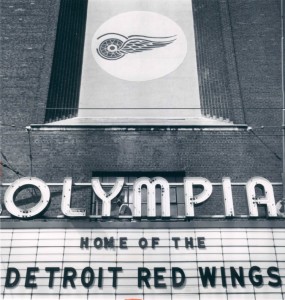This Day in Hockey History – April 5, 1932 and 1955 – Three for Two Left Wings
They played on the same date 23 years apart, but left wingers Harvey “Busher” Jackson and Ted Lindsay set and tied the record for most goals in one playoff period. On April 5, 1932 and 1955, respectively, they each scored a hat trick within the second period of a playoff final.
In 1932, Jackson’s Toronto Maple Leafs swept the New York Rangers in a best-three-of-five series to win the Stanley Cup. It was the first sweep in Stanley Cup history. Toronto had had a rocky season. By replacing coach Art Duncan with Dick Irvin, they jumped from last to first place in just one month. However, they finished second (with a 23-18-7 record) to the Montreal Canadiens in the Canadian Division. Meanwhile, the Rangers won the American Division (with a 23-17-8 record). They went on to eliminate the Canadiens in the first round of the playoffs. Toronto knocked out the Chicago Blackhawks then the Montreal Maroons.
With 53 points (28 goals and 25 assists), Jackson led the scoring race for the 1931-32 season. He had joined the Maple Leafs in 1929 and played with them until they traded him to the New York Americans in 1939. After two years there, he was traded to the Boston Bruins, where he remained until his career ended in 1944. When the 1932 playoffs ended, Jackson had five goals and two assists for seven points, just one behind his teammate, the lead scorer, Charlie Conacher.
Jackson’s biggest night was the first game of the series, Tuesday, April 5. A whopping 18,000 came to Madison Square Garden to watch the visiting Maple Leafs beat the Rangers 6-4 with the “speediest hockey New Yorkers have seen this season.” The first period ended with a 1-1 tie. Then, the Leafs went on a “wild scoring spree in the second.” Jackson took a short pass from Hap Day to score at 3:35. Then at 10:20, he took another pass to score, and only 30 seconds later, Conacher squeezed in a goal. Finally, at 17:05, Jackson scored “on a long drive.” The Rangers got on the board again at the end of the second and beginning of the third. In the last minutes of the game, at 18:32, the “whole Ranger team was in Toronto territory” in a “furious attempt to turn the trick,” so Red “Horner and Jackson stole off on a foray of their own, Horner netting the disk on a pass from Jackson.”
The Leafs proceeded to score six goals in each of the next two games. Only 13,000 attended the middle game at Boston Garden on April 7, when Toronto won 6-2. The Rangers got the first two goals of the game. Less than a minute after the second one, Jackson “ragged the puck into the New York zone, fooled Brennan neatly, and scored. Charley Conacher registered an unassisted tally to tie.” The Leafs sunk four unanswered goals throughout the third period. For the final game, on April 9, 14,500 watched the action at Maple Leaf Gardens. The Leafs’ Andy Blair scored the only two goals in the first period. Then in the second, Jackson “blasted in Toronto’s third goal with a sparkling combination play with Primeau and Conacher.” The Rangers joined the party thanks to Frank Boucher, who scored the last two goals of the game within two minutes. Still, Toronto won 6-4. These scores led to the nickname “the tennis series.” The Leafs’ victory also meant that Conn Smythe kept his vow of building a better team than the New York team he had been fired from.
 In 1955, both the Detroit Red Wings and the Montreal Canadiens had faced the suspension of their star players. Detroit’s captain, Lindsay, had received a 10-game suspension after hitting a spectator with his stick back in January. Meanwhile, Maurice Richard’s suspension caused riots in Montreal. Still, the two teams placed first and second, respectively, with Detroit’s 42-17-11 record and Montreal’s 41-18-11 record. In fact, by the time of the April 5th game, Detroit had not lost a game in seven weeks, since before February 27. Their 15 consecutive wins set a record, breaking the record 14 set by the Boston Bruins during the 1929-30 season 25 years earlier.
In 1955, both the Detroit Red Wings and the Montreal Canadiens had faced the suspension of their star players. Detroit’s captain, Lindsay, had received a 10-game suspension after hitting a spectator with his stick back in January. Meanwhile, Maurice Richard’s suspension caused riots in Montreal. Still, the two teams placed first and second, respectively, with Detroit’s 42-17-11 record and Montreal’s 41-18-11 record. In fact, by the time of the April 5th game, Detroit had not lost a game in seven weeks, since before February 27. Their 15 consecutive wins set a record, breaking the record 14 set by the Boston Bruins during the 1929-30 season 25 years earlier.
During the seven-game finals, each team won all of their home games. The top-ranked Red Wings had home-ice advantage for four games, giving them their second consecutive Stanley Cup. The first two games were won by Detroit at Olympia Stadium. Montreal won the next two at the Forum. Then the teams alternated with the fifth and seventh won by the Red Wings at Detroit and the sixth by the Canadiens at Montreal.
Despite “still playing with his injured shoulder in a brace,” Lindsay had his big moment during the second game of the series, before 13,942 at Olympia Stadium. With a score of 7-1, Detroit just missed having a shutout when the Canadiens scored midway through the third period. From the penalty box, he watched his teammate Marcel Pronovost score the first goal (at 2:15 of the first period). About a minute later, Montreal replaced goalie Jacques Plante with Charlie Hodge. That turned out to be a bad idea. At 9:57, Lindsay (“jabbed home [Gordie] Howe’s passout.” As the 16th minute approached, Detroit’s Terry Sawchuk had to leave the net to get five stitches over his left eye. Shortly thereafter, his teammate Alex Delvecchio scored, and Howe followed that up at 17:11.
Although Montreal pulled Hodge and sent Plante back in for the second period, Lindsay “personally spearheaded one of the wildest and most satisfactory playoff triumphs ever enjoyed by the Red Wings.” His three goals came at 8:10, 15:48, and 19:37. For the last goal, he “took a pass from Dutch Reibel and roared in on Plante. He lost control of the puck but it rolled in anyway.” He tied Jackson’s record of three goals in one playoff period and was the first (since 1926) to score four goals in a finals game. With that goal, Lindsay earned his 15th point in the playoffs, setting a club record. In honor, “the linesman took the puck out of play and gave it to the Wing bench to save for Lindsay’s trophy case.”
The club record of 14 playoff points was set by Don Grosso in 1942 (in 12 games) and Carl Liscombe in 1943 (in 10 games). Only in the sixth playoff game that season, Lindsay had topped them. After Howe’s goal and three assists in the same game, he tied with 15 points. The NHL record was 18. Both Lindsay and Howe ended up topping that by the end of the 11 playoff games, with Lindsay’s 19 points and Howe’s 20. Furthermore, their line (with Dutch Reibel) had already amassed 39 points by the April 5th game. The NHL record was 48, and by the end, they had 51.
Lindsay skated with the Red Wings from 1944 to 1957 and again during the 1964-65 season, so he won the Stanley Cup championships four times. In between, he played for the Chicago Blackhawks from 1957 to 1960. Lindsay was inducted into the Hockey Hall of Fame in 1966, and Jackson joined him in 1971.
Additional Sources:
- Brian McFarlane, Brian McFarlane’s History of Hockey (Champaign, Ill.: Sports Publishing Inc., c1997), 34-35 and 76.
- Jim Kahn, “Leafs Fall on Rangers,” New York Daily News, 6 April 1932, p. 48.
- “Rangers, Leafs Resumer Series on Boston Ice,” New York Daily News, 7 April 1932, p. 48.
- “Rangers Lose Again, 6-2,” New York Daily News, 8 April 1932, p. 55
- “It’s All Over! Leafs Win, 6-4!,” New York Daily News, 10 April 1932, p. 71.
- Marshall Dann, “Wings Crush Canadiens, 7-1,” Detroit Free Press, 6 April 1955, pp. 1 and 23.
- Bob Latshaw, “That Wasn’t Rocket Exploding on Ice,” Detroit Free Press, 6 April 1955, p. 23.
- Dink Carroll, “Lindsay Scores 4 Goals as Wings Rout Canadiens 7-1,” Montreal Gazette, 6 April 1955, pp. 21.














